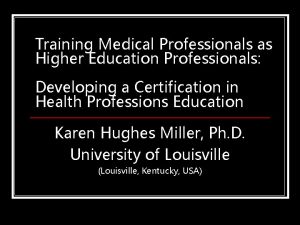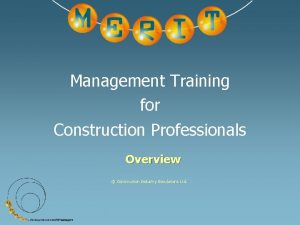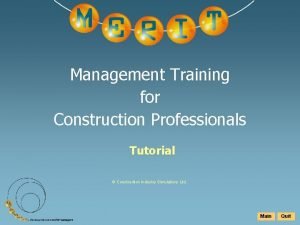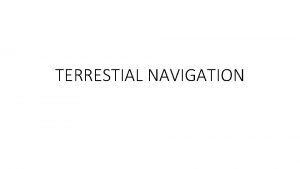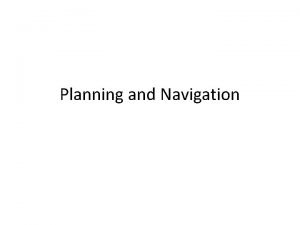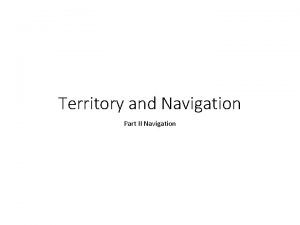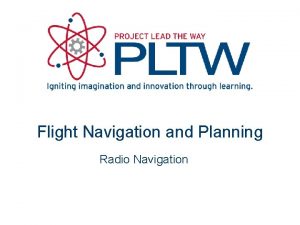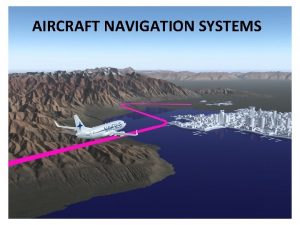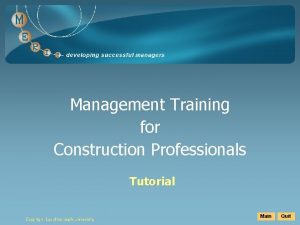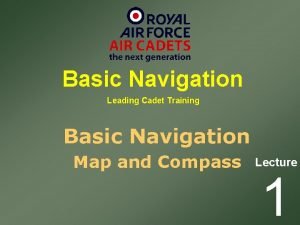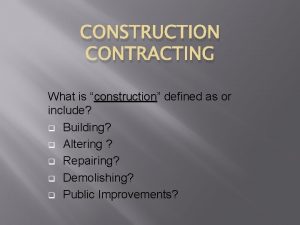Management Training for Construction Professionals Overview Navigation Overview



















- Slides: 19

Management Training for Construction Professionals Overview

Navigation Overview 1/14 The overview consists of a number of slides that introduce the various features of the MERIT simulation. Navigate through the overview by using : buttons for movement through the presentation Ø Ø Ø Demo Hotspot The mouse, buttons for self-paced demonstrations of topic hotspots to display further information. and not the keyboard, should be used at all times. Quit

Introduction Overview 2/14 MERIT is an acronym for Management, Enterprise, Risk, Innovation and Teamwork. It is a computer simulation that gives participants, grouped into a team, the opportunity to experience managing their own fictional construction company, and in a safe, but realistic and challenging environment. It is particularly designed for either : - Ø Undergraduates studying on an appropriate engineering degree programme, such as Civil Engineering or Construction Management. Ø Professionals already working in the construction industry. Participants are exposed to aspects of construction management with which they are possibly either unfamiliar or unpractised, and by allowing them to investigate the interlocking nature of the decisions they make regarding the different areas of company management, a more holistic perspective of the whole construction process is engendered. Benefits Quit

Key Features Overview 3/14 The MERIT simulation introduces many of the key concepts and problems faced in the Construction Industry today, such as : - Ø The importance of forming a company strategy Ø The need for effective teamwork and communication skills Ø Ways of measuring company performance Ø Controlling the company's finances, and looking after shareholder interests Ø Managing the company’s overheads Ø The importance of Marketing, and the need for accuracy in estimating Ø Different procurement methods, including traditional lump sum and design & build Ø Building relationships with clients, and using external consultants Ø Managing the construction of a project to completion, and managing risk Ø Personal management, and picking the right people for the job The learning aspects of MERIT are enhanced in a number of ways : - Ø An interactive tutorial, in the form of a slideshow, guides the user through the simulation Ø A detailed set of company reports are available in different formats Ø Feedback is given each round about company performance in each business area from an external consultant Ø Overall company performance is measured by key performance indicators and company performance statistics that are available at all times Quit

Objectives Overview 4/14 Participants form a management team of up to 6 directors, and are given the task of taking over and running a construction company that has been operating for at least one simulated year, and has : - Financially Ø Assets in the form of : • Cash in the bank • Capital Base (plant, equipment etc) • Investments in other concerns Ø Shareholders to consider People Ø Overhead staff involved in key company activities not based on site : • Marketing • Estimating • Head Office • QHSE • Measurement Work Ø A number of jobs in progress Ø A number of jobs at the procurement stage that can either be : • Costed • Bid for Ø Site Operatives and Project Managers progressing on-going jobs Ø Existing relationships with a number of Clients Quit

The stages of MERIT Overview 5/14 Starting from the historical position of one year’s trading, a company must be managed through two timeframes : Phase 1: The early years The management team, operating as a board of directors, runs the company for a number of periods, where each period represents one trading quarter, in a simulated construction market. At this stage they will be competing for jobs with a computer-simulated company, and the market is updated regularly to reflect changing conditions. Phase 2: The final years (optional) Many other teams may be taking part in the Early Years, and the top 6 teams at the end of the Early Years are invited to compete in the final years, for a further number of periods. During this stage they will be competing in an even more competitive environment, for both jobs and people against the other Final Years’ teams and the computer-simulated company. The stages of MERIT Quit

Making Decisions Overview 6/14 A team is normally given a week to enter the decisions for each round (one period, or 3 simulated months), although this can be varied as required. Software known as the Team Module is used to enter the decisions into an access database, which is sent to the Game Controller for processing, normally by e-mail. As well as the decision entry, the Team Module has a number of other functions : - Ø Obtaining information that enables effective decisions to be made. This can be in the form of : · Reports · Interactive information · Company and Financial Information relating to the environment in which the company is operating e. g. , tax and interest rates Ø Measuring company performance by : · Examining the Performance Review compiled each period by an external consultant · Determining the progress of the Company against a set of key performance indicators, including operating profit and share price · Examining company performance statistics The Decision Process System Requirements Quit

The Key Decisions Overview 7/14 The key decisions that have to be made each period relate to : - Ø The company’s finances, including the company’s cash account, capital base (plant, assets etc), investments and share price. Ø The company’s overhead departments, which are Marketing, Estimating, Qhse, Head Office and Measurement. Ø Procuring work, which involves pricing the jobs for which the company has prequalified, and having done so, finalising and submitting bids in order to secure the work. Ø Progressing each contract awarded by managing the labour force and site staff, and allocating a project manager to the site. The simulation is designed to demonstrate the interdependence of these decisions, and the interlocking nature of the variables that determine the success or failure of the company. Quit

Company and Financial Information Overview 8/14 As well as their own decisions, a number of other factors affect a company’s performance. These are referred to as Company and financial information, and define the environment in which the company is operating. Most remain fixed, but some can vary each period, such as the interest and tax rates. Quit

Company Strategy Overview 9/14 The decisions made each period need to be based upon a sound company strategy which reflects : - Ø The objectives of the Company Ø How the objectives are to be achieved In order to decide upon the objectives, and what can be realistically achieved, there needs to be a detailed analysis of : - Ø The environment in which the company is operating Ø The strengths and weaknesses of the business as it stands Ø The likely competition in the future The areas that need to be considered in the company’s strategy include : Ø What level of growth the company should aim for Ø What to do with any cash reserves Ø What staffing levels are required for the company’s overhead departments Ø Which market sectors the company wishes to target Ø What level of margin to aim for during tendering Ø What type of labour to employ to progress jobs Determining company strategy Quit

Measuring the Company’s progress Overview 10/14 A number of key performance indicators are used to measure the progress of a company : - Ø Turnover Ø Gross Profit to Turnover ratio Ø Operating Profit to Turnover ratio Ø Company Value Ø Capital Employed Ø Contract Completion Rate Ø Forward Workload Ø Forward Margin Ø Share Price Ø Client Satisfaction The indicators are all weighted at the start of the early years to reflect their variability, and initially sum to 1000. As each period passes so the indicators rise and fall, with the total giving an overall indication of the company’s progress. Quit

Teamwork Overview 11/14 The MERIT simulation has been designed to encourage the separation of team member responsibilities into different managerial functions to foster better teamworking, and the success or failure of the company may well depend upon the effective interaction between the different factions. For example, a typical scenario for the structure of a team might be : Managing Director Financial Manager Overhead Manager Responsible fpr : - Responsibility for : - § Managing the company’s assets • staffing the Overhead Departments § Looking after the interests of the shareholders • Seeking out new work that the company can prequalify for Procurement Manager Construction Manager Responsible for tendering for jobs by : - Managing jobs awarded by: - • costing jobs prequalified for • Allocating project managers to oversee the work • bidding for jobs that have been costed • Allocating labour and site support to progress them Quit

The Website Overview 12/14 The website, (http: //meritgame. com) is the focal point for information relating to any MERIT Competition , and whilst the competition is running it will display, amongst other things : - Ø A list of competing teams and associated details Ø The very latest MERIT Leaderboard, as illustrated below Quit

Trialling the Simulation Overview 14/14 As well as the challenging 'fun' side of taking part in a MERIT Competition , it is primarily a serious training vehicle, enabling participants to gain an understanding of the complexities of running a modern construction company, and the inter-relationship between the various functions of the business. For participants to manage their fictional company as productively as possible, they need to spend time learning how to use the simulation. The powerpoint Tutorial is a detailed guide to using the simulation, but it is still no substitute for practice. With this in mind, all competing teams are normally given time to 'trial' the software. During the trial phase, a team can make decisions for one round as often as they like, although normally 2 or 3 attempts should suffice. The decisions will be processed and returned, and should enable the team to gain an understanding of the concepts and pitfalls involved in running their company prior to the start of the ‘live’ Competition. Quit

Demo: The stages of MERIT Glossary The Youyou If your Company historical take are company control involved has phase is already ofone in the normally the of Company been MERIT thelasts most operating at competition 4 successful the periods, beginning for aor for number during one of both trading period Phase of Phases trading 5. year, 1, you You 1 and quarters, starting may then 2, be you manage invited from known will as period the to normally the take company historical 1. part be managing in through the phase, Phase ayour before number 2, company theyou of final periods, take for years. 14 over periods, normally You thethen itsor 8 management. have (two 3 andto trading half manage trading years). theyears. company This is known asa. Phase through further 1, the number earlyof years. periods, normally 6, in direct competition with the Each othertrading top companies quarter, from or 3 months, the earlyisyears. referred to as a period. Start of History Period 1 Start of Phase 1 2 3 Historical Year 4 5 Start of Phase 2 6 …………. 12 Phase 1: The Early Years 13 14 …………. 18 Phase 2: The Final Years Keep Clicking Anywhere The Demo on is the now screen complete to advance the demo Quit

Demo: The Decision Process Glossary The demonstration interaction between the Controller and the between team continues for Early This shows the. Game interaction that occurs a team and the Game The History has been completed for the company being managed by Team 1, and the Years, which normally lasts for 8 rounds, or two simulated years. Controller. team is currently at the start of period 5. It is assumed that the Team Module has already been installed on at least one PC. For the purposes of this demo the team has the unique team number of 1. Game Controller Team 1 The Game. The Controller will now process for period The 5. that Team Game Controller e-mails the decisions team to inform the Module is used to enter the company’s forshould periodbe 5. downloaded either The database merit 2013_t 1 p 5. dat company database for period 5 is available in the online store. decisions It When the is decisions been processed where the period to period 6, and company through theupdated MERIT Team module or the via new the MERIT website labelled have merit 2013_t 1 p 5. dat : - will be database, merit 2013_t 1 p 6. dat, will be available the on-line store, would and the normally process have continues. week to do this, Havinginentered their. They decisions for the period 5, a the team although may upon time must now press the submit this button tovary senddepending the database • merit 2013 is the game identifier Key Point • t 1 represents team 1 constraints. merit 2013_t 1 p 5. dat back to the Game Controller. Each company database supersedes the previous one, and contains all historical information. • p 1 represents period 5 Keep Clicking Anywhere on is the screen to advance the demo The Demo now complete Quit

Demo: Company Strategy Glossary It’s the analysed beginningthe of period 5, information and the Company’s strategy needsupon to bethe established Having available the Company decides following for the Objectives To be achieved by next year. objectives principal policies for achieving In the nextand year the Company will attempt to them. achieve the objectives established in the Steady growth, with at least a doubling ofreflect the • policies Prequalifying for more work through an increased strategy by entering decisions that it wishes to adopt. In order to decide upon its objectives the company needs to review the environment in turnover in the next year. market presence which it is operating, its strengths and weaknesses and the likely competition. • Procuring more work through the tendering process However, it may be that the objectives are unattainable for any number of reasons : This is possible by referring to : - • Increasing the company’s operating profit Ø The Company’s future market forecasts are • inaccurate, anduse the Making better of anticipated the company’sgrowth assets Improve the value of the company. Reports that are available On-line information areas will not materialise, reducing the expected value of work that the company can prequalify for Manage company overheads efficiently to help Identifying overhead requirements, such as Ø Increased competition will force margins to be reduced work QHSE and achieve profitable growth. ensuring that to thesecure Head Office, departments can cope with the Ø Jobs will be lost to competitors with better Meaurement client relations company’s turnover. Ø Project managers employed to oversee contracts will not perform as expected because the personnel department correctly Raise the company share price did not assess their • abilities Maintaining a healthy dividend • Improving future profitability • Increasing the company’s value Hence it is necessary for the state of the Company to be reviewed continuously in order to Build on and improve relationshipsare withbeing all met, and. Submitting and company managing determine if the objectives it may be competitive necessary bids, for the clients well strategy to be revised before the next year is contracts completed. Keep Clicking Anywhere on is the screen to advance the demo The Demo now complete Quit

Benefits Glossary The main benefits of using the MERIT simulation are : - Ø It develops a greater understanding of the problems and decisions that are involved in running a modern construction company Ø Its practical and competitive nature enhances the learning environment Ø It improves team-working, communication and IT skills Ø It develops analytical and problem-solving techniques Ø It enables performance to be benchmarked against other competing teams Quit

System Requirements Glossary To be able to take part in a MERIT Competition , at least one member of the team will require : - Ø A computer running on the Windows operating system (XP or above) Ø A pentium processor, or equivalent Ø Access to a printer Ø An e-mail address for sending and receiving information Ø Access to the Web to view the information about a game The MERIT software is a single-user version for loading on individual PCs. Quit
 Training for higher education professionals
Training for higher education professionals Fspos vägledning för kontinuitetshantering
Fspos vägledning för kontinuitetshantering Typiska novell drag
Typiska novell drag Tack för att ni lyssnade bild
Tack för att ni lyssnade bild Returpilarna
Returpilarna Varför kallas perioden 1918-1939 för mellankrigstiden
Varför kallas perioden 1918-1939 för mellankrigstiden En lathund för arbete med kontinuitetshantering
En lathund för arbete med kontinuitetshantering Särskild löneskatt för pensionskostnader
Särskild löneskatt för pensionskostnader Tidbok för yrkesförare
Tidbok för yrkesförare A gastrica
A gastrica Densitet vatten
Densitet vatten Datorkunskap för nybörjare
Datorkunskap för nybörjare Stig kerman
Stig kerman Debatt mall
Debatt mall Delegerande ledarskap
Delegerande ledarskap Nyckelkompetenser för livslångt lärande
Nyckelkompetenser för livslångt lärande Påbyggnader för flakfordon
Påbyggnader för flakfordon Arkimedes princip formel
Arkimedes princip formel Svenskt ramverk för digital samverkan
Svenskt ramverk för digital samverkan Jag har nigit för nymånens skära text
Jag har nigit för nymånens skära text
